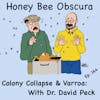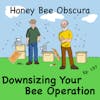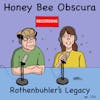Keeping Small Colonies (159)

In this week's episode, Jim is delighted to welcome back David Peck from Betterbee. In this intriguing discussion, they explore what Jim calls, "Reverse Beekeeping," a unique approach that focuses on maintaining smaller bee colonies. Traditionally,...
In this week's episode, Jim is delighted to welcome back David Peck from Betterbee. In this intriguing discussion, they explore what Jim calls, "Reverse Beekeeping," a unique approach that focuses on maintaining smaller bee colonies.
Traditionally, beekeeping has been all about growing large colonies for honey production and pollination. This has led to bee breeders selecting for traits that encourage large and rapid brood development and has influenced the design of beekeeping equipment, like the standard 10-frame boxes. However, managing these large colonies can be physically demanding. In today's conversation, Jim and David discuss the advantages of reducing colony size and the management techniques suited for these smaller hives.
A significant aspect of managing smaller colonies is dealing with honey-bound boxes, which can lead to more frequent swarming. David shares insights into how beekeepers can address this, whether by making splits when the colony grows large or by letting them swarm naturally. Another interesting topic is the practice of occasionally caging the queen, known as ‘queen break,’ which can be an effective strategy for controlling colony size and as a side benefit, help manage varroa mite populations.
The discussion also touches on the concept of 'queen quality' in smaller colonies. What might be considered a less desirable queen in a large honey production or pollination operation could actually be the ideal choice for smaller colonies. Jim and David delve into how this shift in perspective can impact beekeeping practices.
Join us in this fascinating episode as Jim and David delve deep into the nuances of keeping smaller bee colonies, offering a fresh take on traditional beekeeping methods.
______________________
Thanks to Betterbee for sponsoring today's episode. Betterbee’s mission is to support every beekeeper with excellent customer service, continued education and quality equipment. From their colorful and informative catalog to their support of beekeeper educational activities, including this podcast series, Betterbee truly is Beekeepers Serving Beekeepers. See for yourself at www.betterbee.com
______________________
Honey Bee Obscura is brought to you by Growing Planet Media, LLC, the home of Beekeeping Today Podcast.
Music: Heart & Soul by Gyom, All We Know by Midway Music; Christmas Avenue by Immersive Music; original guitar music by Jeffrey Ott
Cartoons by: John Martin (Beezwax Comics)
Copyright © 2023 by Growing Planet Media, LLC

Episode 159 – Keeping Small Colonies
[music]
Jim Tew: Honey Bee Obscura, it's that time of the week again where we talk about all things beekeeping. I'm here with Dr. David Peck from Betterbee and we're going to be chatting about a topic that may be considered strange by some. It's that group of beekeepers, and I'm in the middle of them, Dr. Peck, who don't necessarily want the biggest producing mountain output of a colony you can have. There are reasons that some people would want a lesser beehive and that's the problem. What do you think, Dr. Peck?
Dr. David Peck: It's a common problem. I talk to folks at Betterbee all the time who say, "I just can't do what I used to do," "I can't lift what I used to do," or "I've moved to a smaller place," and "Why can't I just have a smaller hive?" I think we can have a lot of fun today just talking about why you might want a smaller hive, how you can get one, and why it is challenging, why it's a little bit hard to do, because the bees don't always agree with you that they ought to be a small, petite, easy-to-manage colony.
Jim: [laughs] I agree with you perfectly. Nicely said. Hi. I'm Jim Tew.
David: Hi. I'm David Peck from Betterbee.
Jim: We're here at Honey Bee Obscura where, today, we want to talk about reverse beekeeping, keeping small hives, not big hives.
Introduction: You are listening to Honey Bee Obscura, brought to you by Growing Planet Media, the folks behind Beekeeping Today Podcast. Each week on Honey Bee Obscura, hosts Kim Flottum and Jim Tew explore the complexities, the beauty, the fun, and the challenges of managing honey bees in today's world. Get ready for an engaging discussion to delight and inform all beekeepers. If you're a long-timer or just starting out, sit back and enjoy the next several minutes as Kim and Jim explore all things honey bees.
Jim: David, it's just me, but I have to admit that even when I was not as old as I am right now, when you went into a bee yard and there's three deeps and three supers on 35 or 40 colonies and off to one side are four or five six-frame nucs, which ones do you think just call to me? If you needed a bee fix, you can go over there and you can remove 100 pounds of honey and take off that top deep and deal with 70,000 bees just to do whatever it is you want to do, or you can go over there and pop off the top off that six-frame nuc and not use any smoke in most cases and get your bee need fix.
I've always had this penchant where I said to you a bit ago, I'd rather work with puppies than work with big bulldog, aggressive animals. It's easier to go and work these small units. As I've gotten older and a personal thing is I do some photography and videography, and so you got all the camera gear out, and then you got all these bees opened up, all this big equipment, all this honey and stringing honey everywhere, it's just not as convenient as it is to work a small hive.
David: Well, I don't think it is just you. I think that there's a lot of beekeepers who feel the same way. I certainly did when I was going out and doing research. I knew I had to get into the brood nest every couple of days to do some manipulation. I wasn't happy when my colonies made 100 pounds of honey because that's 100 pounds of honey I have to work through. Honey is a waste byproduct if you're doing the beekeeping for the bees and not for the honey. It's just a big, old heavy burden.
Jim: That's an interesting way of wording it, a waste byproduct if you don't want it.
[laughter]
David: I think there's a lot of beekeepers who would be perfectly happy with small hives, but the bees don't always agree with you. Bees would rather be big. They'd rather make a lot of honey and have lots of family members. When we're trying to engineer a way to have that pleasant experience of smaller-scale beekeeping or more manageable beekeeping, in many ways, we're sort of fighting against the bees' natural instincts to grow, grow, grow.
Jim: Yes, and that grow, grow, grow now, that converts to swarm, swarm, swarm. It really depends on you, the beekeeper's situation. In my case, I have a long rectangular acre in a suburban area. I have neighbors fairly close on the sides, but not anything close on the ends. I keep my bees all the way back, but I have to respect my neighbors. I really don't need 10 or 15, 60,000 bee-populated colonies in my backyard to defecate on my neighbor's house and car and swarm in their yard and whatever.
I would really rather have a manageable colony, a friendly colony there that you can go out, quick look, find the queen, make a quick picture, here's Varroa, snap back, close it all up, and be gone. Maybe it's just where I am. Now, you said a bit ago, honey was a waste byproduct. There was a time when I just could not make enough honey, but I've written several times that honey processing is not beekeeping.
It's a totally different world. it's honey pumps and extractors and filters and buckets and strainers. Nothing about that is beekeeping, so it's a totally different world. When I was in the honey world, I enjoyed it. I want enough honey now for my bees to survive, but I'm not really a honey producer now. If you're out of that, I want smaller colonies. If I just put them in a small box and tell them, "Here, just live in this one-bedroom apartment instead of a four-bedroom house," what do you think they're going to do?
David: They're going to follow their instinct. Their instinct is grow until you fill your space and then split so that you can go grow somewhere else. I think that the challenge of how somebody can do this is probably worth diving into. What are the different techniques that you might use to keep your bees on a smaller scale and what works and what doesn't and what are the upsides and the downsides of it?
As you say, the first option is just using smaller equipment, basically just putting your bees into one box or two boxes and saying, "That's it. I'm not giving you any supers. I'm not giving you any space." What you get is bees that will go out on a honey flow and make honey. Eventually, they'll wind up honey bound. They bring home enough nectar that they plug up their brood nests. That is one of the surest signs to the bees that they've filled up and so it's time to get ready to swarm.
As a beekeeper, you can really drive yourself crazy going in, taking apart boxes every couple of days, and ripping out swarm cells. If your strategy is to just put them in smaller equipment, you might have to just say, "All right, I'm going to put them in smaller equipment," and then tolerate that swarming process. If you're trying to keep smaller hives so that you don't upset your neighbors, having swarms move into their attic is probably not the best way to make friends.
Jim: I want to stop at point number one. That is a good point. The simplest thing to do is the easiest thing to do and that's just crowd them. I boldly went out two years ago and thought, "Okay, you're going back to where you started. You're going back to a single deep. I'm going to confine you there."
David, I want to tell you about the anxiety that you feel as a beekeeper when you go out and realize that that single-deep colony is crowded out of his mind and you think, "Okay, all right. All right, just this season, I'm going to add another deep because I can't stand to look at this colony this crowded." I'm the one who broke as often as the bees were the one to swarm just because you are going against established beekeeping protocol for letting that colony get that crowded. The easiest thing to do is just let them get crowded and let them swarm.
David: The other thing, you mentioned the idea that when you go into an apiary and you've got one big honking hive covered in honey or a bunch of little ones, you'd rather go work with the little ones. Well, one way to do that is whenever a colony starts to grow, you can just split them. You can just split up, basically control that swarming instinct that they were about to start leaning into, and just turn one colony into two, two into four, four into eight. If you're a real crummy beekeeper, most of them will die in the winter, and you'll be back where you started in the spring. [laughs]
Jim: Well, I was thinking that exactly. It's a Sisyphean circle, isn't it? You just keep rolling the rock.
David: Right, exactly.
Jim: It's because all you're really doing-- I'm not heartless about bees because everything about this, the devil is always in the details. When you say let them die in the winter, of course, I've done that. We've all done that. What about that day when I go out there on that winter day and it's time to spring day to begin to clean up that winter kill? That is not a pleasant beekeeping task. On those days, you think, "Why are there no cameras out here photographing this? Why are there no exciting exposés, enjoy them but in full film on the cleaning up dead-outs?" Everything is in the details.
David: Absolutely.
Jim: They're going to die anyway. You're right. They're going to swarm. I would argue that even in the wild, bees are dying all the time. Most swarms are not successful. Most swarms don't find proper nesting sites. Death is a way of life for beekeeping.
David: My PhD mentor, Tom Seeley, has done a great deal of work on bees living in trees. One of the things that he's highlighted is just how small those hives tend to be, about the size of one deep 10-frame hive body. Small beekeeping is, in some ways, natural for the bees, so is swarming, and as you say so is death. Some of his calculations suggest that every colony, more or less, is going to swarm every year, but only one out of 10 of those swarms is going to survive to the following year.
Mortality in nature is pretty common. Maybe as beekeepers, us trying to keep everybody alive all the time is a little bit of a mistake. I think that there is another side of that, though. There's one bee that we have a tendency to kill when maybe we shouldn't be. That could be another route to small colonies. Maybe we ought to take a quick break and then we can come back and talk a little bit about queens and how that might help us wind up with slightly smaller colonies than we've had in the past.
[music]
Betterbee: Now that your bees are wrapped up and tucked in for the winter, let's turn up the warmth with the fascinating world of beekeeping knowledge. Join the hive minds at Betterbee for expert-led classes taught by David Peck and EAS Master Beekeeper Anne Frey. Whether you're a winter beekeeping beginner or a seasoned pro in the apiary, our classes cover everything from snowy basics to advanced insights for the winter beekeeping connoisseur.
We're all about sharing the sweet wisdom our honey bees have taught us. Head to betterbee.com/classes to explore our class offerings and discover the secrets that will make you a beekeeping maestro even in the chilliest season. Because at Betterbee, knowledge is the nectar that sweetens your winter beekeeping experience. Betterbee, where learning and beekeeping keep you warm all winter long.
[music]
Jim: That queen thing you brought up just before the break was really interesting. I'd like for you to pick up there where you were and keep going with that. What about our queen? It's like buying a really big engine for a very small car. Go with that thought that you were working on.
David: Well, if you buy a big engine for a small car, you can go fast. What a lot of beekeepers want is they buy a little package or a little nuc or they make a little split. They want to put a queen in there who's just going to lay so many eggs and the colony's just going to grow so quickly that it'll be going gangbusters by the time the honey flow starts. If you want to make a lot of honey, then you want to buy what we as beekeepers traditionally call a very good queen, a very productive queen.
One of the ways to do that is to have a young queen because a young queen is going to be full of vim and vigor and she's going to be laying egg after egg after egg. Well, as she gets a little older, she'll lay an egg. Maybe she'll grab a bite to eat. She'll lay an egg. Maybe somebody grooms her for a while and then she'll lay another one. If we keep queens a little bit longer, we could wind up with older queens, sure, but queens that are not going to be pushing that growth quite as aggressively.
That might be a way to help tamp down some of those most dramatic increases in the bee population in spring. I think the other point to make is even if you have a young queen, if you don't breed your queens for fast, fast, fast growth and lots and lots and lots of brood, you could wind up with what most folks would call a crummy queen or a mediocre queen who just has a nice gentle growth curve and then the colony tapers down for winter. Maybe that would be a way to help steer towards a slightly smaller, slower, less honey-productive style of beekeeping.
Jim: Just lower your queen expectations or your queen demands.
David: Maybe just have different expectations. Demand a queen that doesn't grow too fast.
Jim: That too is going to go against the grain with most of us, with many of us, because we are all trained from beekeeping birth to get the most, to control swarming, to produce the most, whatever. All of a sudden, I'm asking now, is there some way to calm that down? A bit ago, you said let them swarm. If you got a queen that's not quite up to par, let her go. Let her go longer and they'll just supersede her.
That, in a way, plays into my plan because the supersedure process keeps them at a reduced level. They're not busy growing because they're making a new queen that I didn't go buy. Now, I want to support queen producers, but that makes no sense to put a $40 queen into a box that you know you're going to let be crowded. Then you're going to see your $40 queen hanging in the tree over there in the neighbor's yard before that season's over.
David: The danger there is you see that queen, you see that swarm, and the instinct as a beekeeper is to go and catch it. If you're catching those swarms and bringing them back, it's nice to have small colonies, but there's a danger if you're splitting or letting the bees swarm and then catching all those swarms that you'll have lots and lots and lots and lots of small colonies.
There'll be more beekeeping work than if you just let them get big. Unless you've got somebody willing to buy your splits or take a spare colony from you here or there in your local beekeeping area, then I think there's a real danger of going too far the other way and having a thousand tiny colonies stressing you out instead of a couple of big heavy ones stressing you out.
Jim: Well, you could combine them and you could turn these tiny colonies back into small colonies, but it's like you don't have any other life. All of a sudden, to keep bees small, you're working yourself to death to keep them small. You could have figured out some way to deal with large beehives if that's what-- It's a trade-off. I'll just go back to one of my opening comments.
I just am drawn to the easy hive to work. It's so enjoyable to work with smaller colonies and to see the bees and to understand biology and to look at some of the things that's going on and see what the books have said. I'm seeing it now in the hive. It makes it all so real. In an earlier segment, we talked about a queen isolation cage. I've wondered if we can isolate queens to some extent. This was strictly my wording. I called it brood pruning. To some extent, control the brood output. I've wondered if we could do something like just cage the queen and some caging device just to restrict her, "Here, take two days off and watch TV," kind of thing.
David: [laughs] There's plenty of folks who have tried that. You can just take a regular, little three-hole queen cage, pop her in there, put a cork in either end, and then seal her up for a while. That's going to limit the number of eggs she lays. If she lays, let's say, a thousand eggs a day and you cage her for 20 days, that's 20,000 bees that you're not going to have to worry about because those eggs didn't get laid. The problem, of course, is if I cage my queen for 20 days and then let her go, she might start laying again or she might not.
In the meantime, the rest of the colony is going to be really upset with me. They're going to be trying to make a queen cell left, right, and center because they can tell, "Something's wrong with Mom. She's not laying the eggs like she's supposed to." I think one slightly better way to do that or one strategy I'd probably lean towards is using something like a frame isolation cage. One of these cages that you can put just one or two frames in. Put your queen in there. Let her keep laying eggs.
Let them still raise some brood. Suddenly, that brood nest has shrunk down to one or two frames instead of all of the frames the queen had access to. Cramp them in a little bit, but don't manipulate the queen's ability to continue to lay a couple of eggs every day for the nurse bees to find a couple of brood of every age that they're going to be able to feed. They just get the sense that everything's all right, that they're still growing. It's just that the brood nest is a little bit smaller this week.
Jim: In a very arrogant way, I am putting my thumb on the scales on this bee brood area. I'm controlling the bee brood output or I'm manipulating it. Instead of just letting her run wild, just lay as many eggs as she can, I'm restricting her. Then I'll move those frames over when I want and keep enough brood there, I hope, to resist that supersedure process, unless that's part of my plan for population suppression. We probably should add a little disclaimer. We know this conversation sounds weird to most beekeepers.
David: Right.
Jim: It's reverse beekeeping. I have reasons. Other beekeepers have reasons. Observation hives. There's one right behind you there that the viewers can't see. Observation hives are a perfect case in point. They want to build up and swarm. If you've got a nice observation hive, unless you want to watch the swarming process, you probably want to restrict that to some extent.
David: I keep an observation hive in my office every fall, winter, and spring. Then come summer, it's time for me to get them out into a hive because, otherwise, it's just a swarm machine. They're piddly, little swarms. They aren't worth their time or my time. When you've only got two deep frames to live on, then you may find yourself getting cramped pretty quickly.
Yes, I agree, but there's folks who have an observation hive or maybe a slightly bigger one, but they have some aspiration of keeping it more or less functional in their hive. What's my first advice to them? Get your worst queen in the apiary. The queen that you were thinking about pinching? Put her in there. When she's starting to wind things down, that's exactly the queen you want in limited quarters.
Jim: One of the things I'd considered in my need for being able to photograph, to get to look to a study is just going with a big observation hive. Years ago, I built one. It's nine frames, three deeps on three deeps on three deeps. The queen, of course, wants to stay in the center, but at least it had glass walls. I kept them covered. Sometimes she was out, but I would like to suggest to some beekeepers. If you just want two or three hives, possibly in some beekeeping world, consider two or three big observation hives because they're easy to open, easy to work. Queen's right there. You have an idea of somewhere where she is, but it's not normal, traditional beekeeping in any way.
David: You're not going to harvest much honey from it.
Jim: You're not. They're probably going to die and there's going to be issues, but you're working with the bees. You're understanding their biology. I just keep telling myself when I'm doing things that are not always best for the biggest and the best is that, in nature, it's not always the biggest and the best either. It's not like I'm giving the bees a lesser life because they would have had a better life in the wild. Many of these swarms, you said a bit ago, die in the wild. They don't thrive from season to season. I'm just accepting the reality of things.
David: Well, Jim, I think we could probably talk about this for the rest of time, but it might make sense for us to wrap up because I think half of your listeners are probably thinking, "What the heck is wrong with these guys? Why would I ever want a tiny colony?" The other ones are taking notes and rushing off to send us an email and ask us more questions.
Jim: Please admit, we realize that we're swimming upstream. Most of my life, I've wanted bigger and better and more, but there's a stage of life and a procedure, in my case, photography, that big hives just don't fit the bill. There's just not many commonly discussed ways to restrict growth. This was our 20-minute effort at doing it. Think about it. If you have some ideas, write us. We'd be glad to hear about it. David, as always, thanks a lot. I enjoy talking to you.
David: It's been a pleasure. I'm always happy to come back and chat with you and your listeners again.
Jim: Thank you, sir.
[music]
New to Honey Bee Obscura Podcast?
Here are some great episodes to start with. Or, check out episodes by topic.







 In this week's episode, Jim is delighted to welcome back David Peck from Betterbee. In this intriguing discussion, they explore what Jim calls, "Reverse Beekeeping," a unique approach that focuses on maintaining smaller bee colonies.
In this week's episode, Jim is delighted to welcome back David Peck from Betterbee. In this intriguing discussion, they explore what Jim calls, "Reverse Beekeeping," a unique approach that focuses on maintaining smaller bee colonies.






